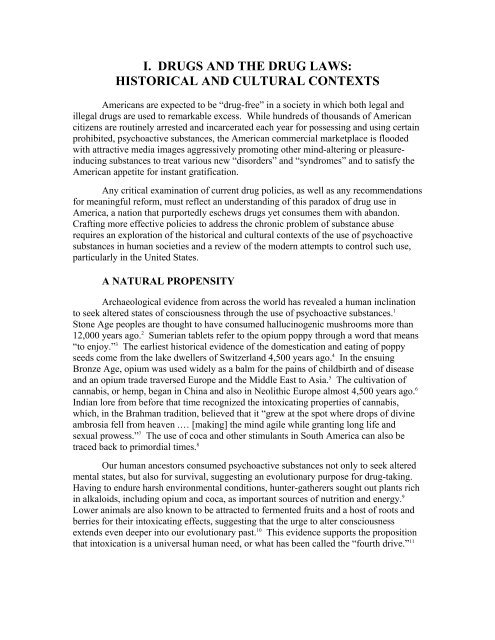Effective Drug Control: Toward A New Legal Framework
Effective Drug Control: Toward A New Legal Framework
Effective Drug Control: Toward A New Legal Framework
Create successful ePaper yourself
Turn your PDF publications into a flip-book with our unique Google optimized e-Paper software.
I. DRUGS AND THE DRUG LAWS:<br />
HISTORICAL AND CULTURAL CONTEXTS<br />
Americans are expected to be “drug-free” in a society in which both legal and<br />
illegal drugs are used to remarkable excess. While hundreds of thousands of American<br />
citizens are routinely arrested and incarcerated each year for possessing and using certain<br />
prohibited, psychoactive substances, the American commercial marketplace is flooded<br />
with attractive media images aggressively promoting other mind-altering or pleasureinducing<br />
substances to treat various new “disorders” and “syndromes” and to satisfy the<br />
American appetite for instant gratification.<br />
Any critical examination of current drug policies, as well as any recommendations<br />
for meaningful reform, must reflect an understanding of this paradox of drug use in<br />
America, a nation that purportedly eschews drugs yet consumes them with abandon.<br />
Crafting more effective policies to address the chronic problem of substance abuse<br />
requires an exploration of the historical and cultural contexts of the use of psychoactive<br />
substances in human societies and a review of the modern attempts to control such use,<br />
particularly in the United States.<br />
A NATURAL PROPENSITY<br />
Archaeological evidence from across the world has revealed a human inclination<br />
to seek altered states of consciousness through the use of psychoactive substances. 1<br />
Stone Age peoples are thought to have consumed hallucinogenic mushrooms more than<br />
12,000 years ago. 2 Sumerian tablets refer to the opium poppy through a word that means<br />
“to enjoy.” 3 The earliest historical evidence of the domestication and eating of poppy<br />
seeds come from the lake dwellers of Switzerland 4,500 years ago. 4 In the ensuing<br />
Bronze Age, opium was used widely as a balm for the pains of childbirth and of disease<br />
and an opium trade traversed Europe and the Middle East to Asia. 5 The cultivation of<br />
cannabis, or hemp, began in China and also in Neolithic Europe almost 4,500 years ago. 6<br />
Indian lore from before that time recognized the intoxicating properties of cannabis,<br />
which, in the Brahman tradition, believed that it “grew at the spot where drops of divine<br />
ambrosia fell from heaven .… [making] the mind agile while granting long life and<br />
sexual prowess.” 7 The use of coca and other stimulants in South America can also be<br />
traced back to primordial times. 8<br />
Our human ancestors consumed psychoactive substances not only to seek altered<br />
mental states, but also for survival, suggesting an evolutionary purpose for drug-taking.<br />
Having to endure harsh environmental conditions, hunter-gatherers sought out plants rich<br />
in alkaloids, including opium and coca, as important sources of nutrition and energy. 9<br />
Lower animals are also known to be attracted to fermented fruits and a host of roots and<br />
berries for their intoxicating effects, suggesting that the urge to alter consciousness<br />
extends even deeper into our evolutionary past. 10 This evidence supports the proposition<br />
that intoxication is a universal human need, or what has been called the “fourth drive.” 11
















